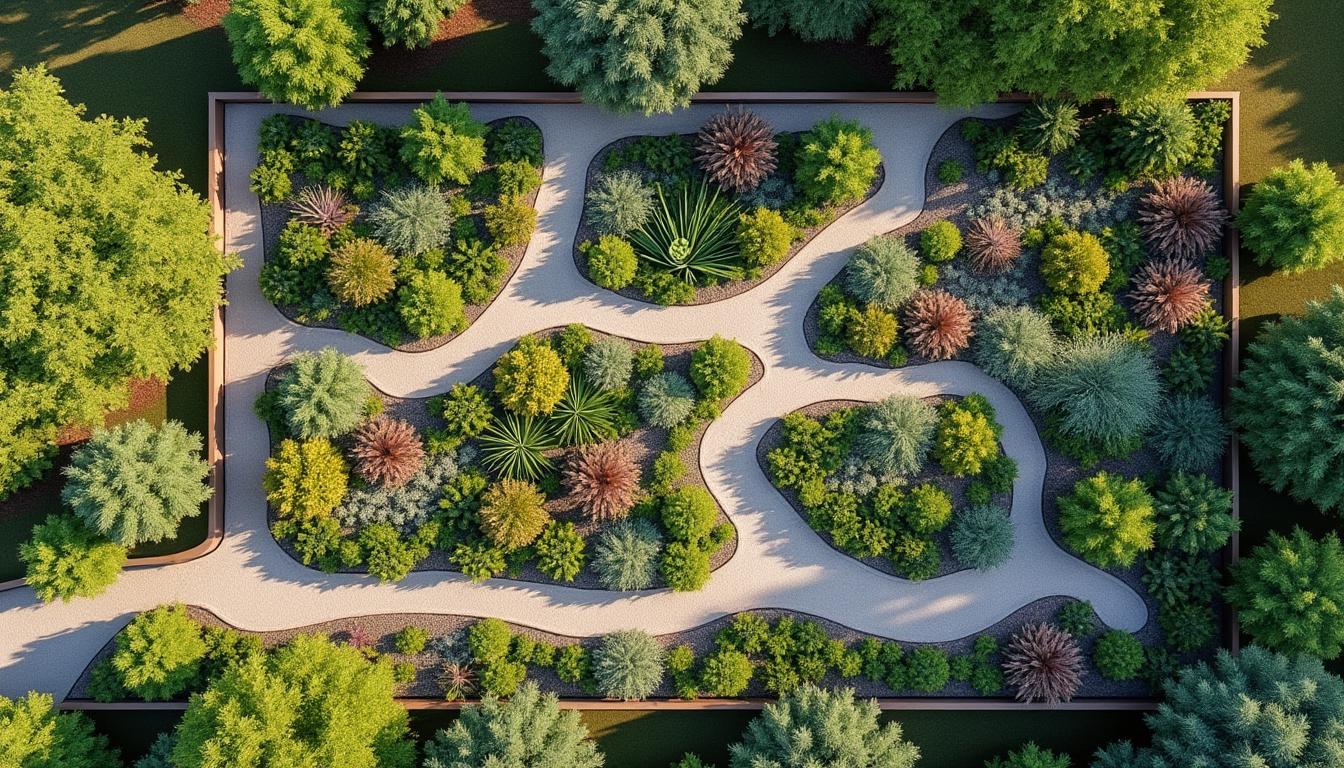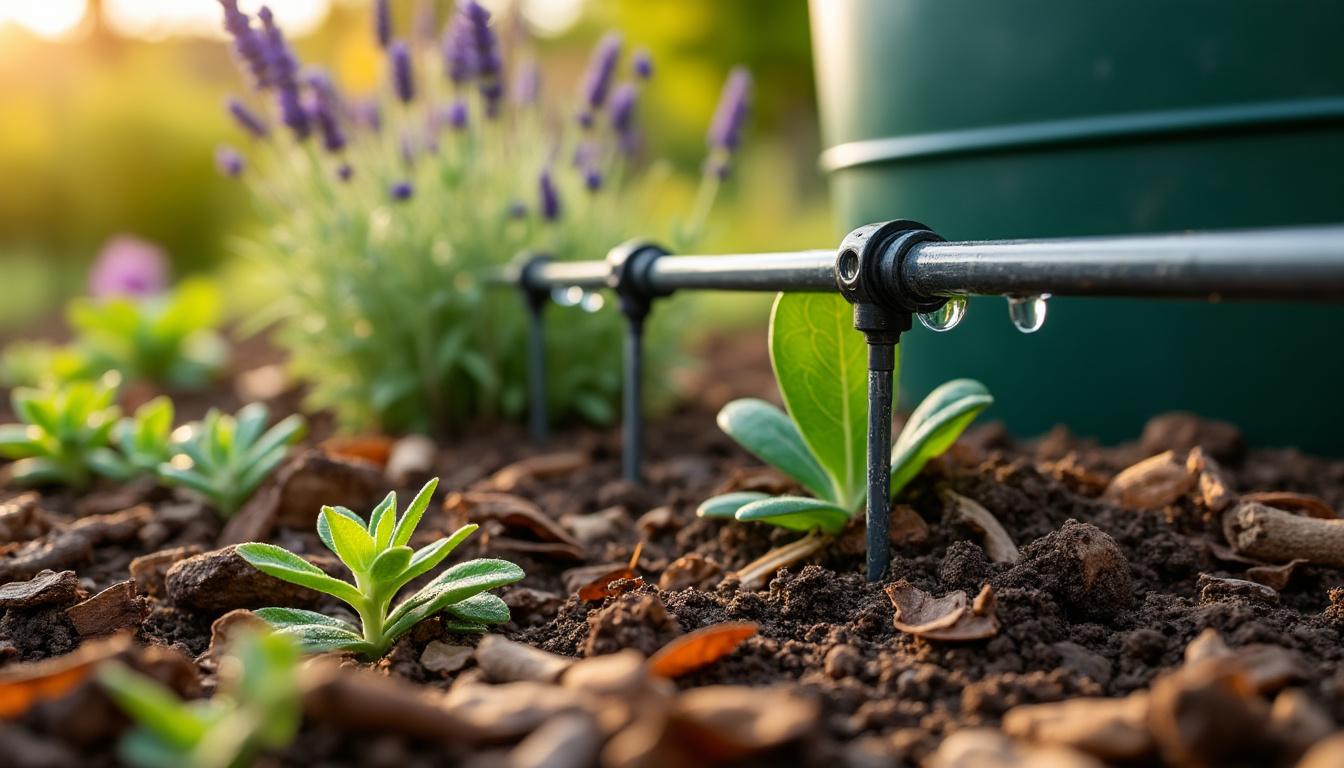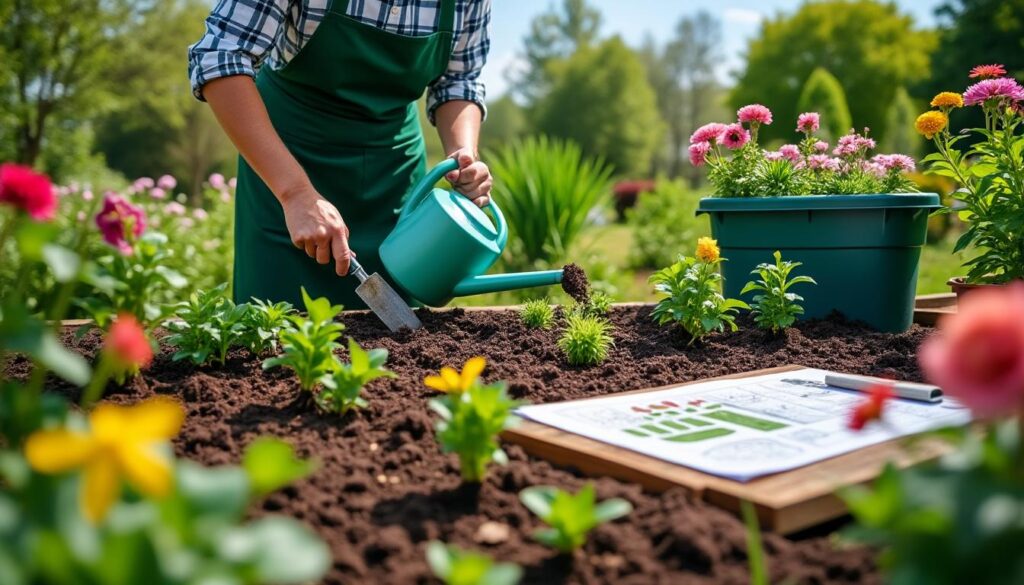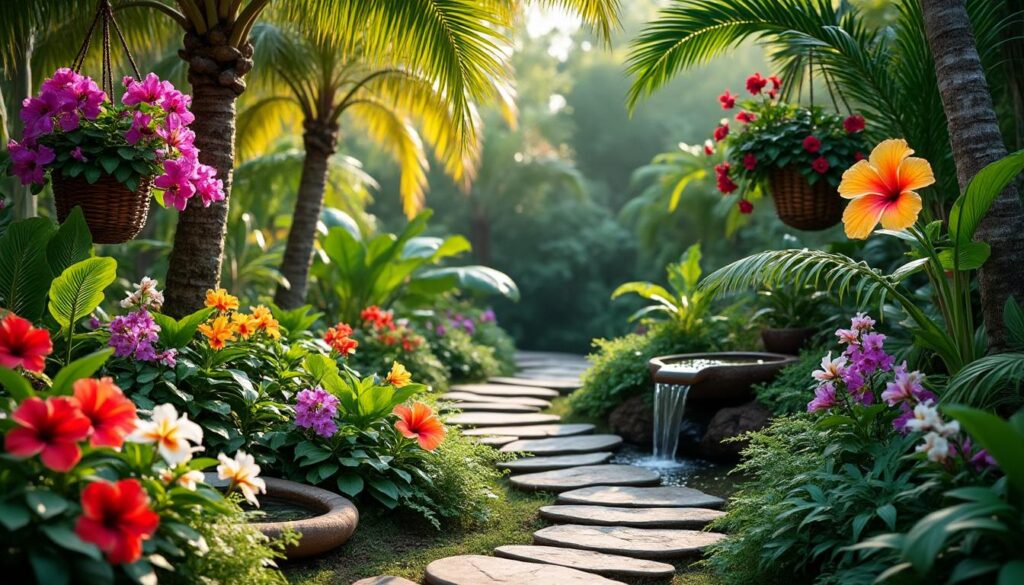Creating a sustainable and economical garden at your home is simpler than it seems. With smart choices, your outdoor space begins to consume less water, produce less waste, and still enhance local biodiversity.
| Short on time? Here’s the essential: | |
|---|---|
| Key Point | Practical summary |
| ✅ Smart planning 🌞 | Map sunlight, wind, and water; replace part of the lawn with low-maintenance beds. |
| ✅ Native plants 🌿 | Choose species adapted to the local climate to reduce watering and fertilization. |
| ✅ Water under control 💧 | Install drip irrigation, cover the soil with mulch, and harvest rainwater in reservoirs. |
| ✅ Living soil ♻️ | Compost organic waste and apply natural fertilizers to nourish the ecosystem. |
| ✅ No chemicals 🐞 | Use biological control, physical barriers, and repellent plants instead of pesticides. |
Ecological planning: sustainable and economical garden design at home
An efficient garden arises from good design. Before planting, it’s worth observing sun incidence, ventilation, and water drainage to position each element correctly.
This mapping prevents costly mistakes, like planting water-demanding species in a full sun and wind zone. By optimizing the design, maintenance, water consumption, and future costs are reduced.
Mapping sun, wind, and water circulation
Observe for a week the light patterns throughout the day, in all seasons. Also note the prevailing winds and where water accumulates after rain.
With this data, organize zones: cultivation that requires more sun, rest in partial shade, garden near the kitchen, and composting area in a ventilated space. The result is a functional and comfortable garden.
- 🧭 Make a simple sketch of the land with sun/shade hours.
- 💨 Create living windbreaks with dense shrubs in exposed areas.
- 💧 Channel rainwater to rain beds or cisterns.
- 🚶 Permeable pathways avoid mud and improve circulation.
Replacing lawns with productive and resilient areas
<pLawns require frequent watering and fertilization. By reducing their area, replace them with native plant clusters, flowering meadows, vegetable gardens, or drought-tolerant ground cover.Besides saving water, this change enhances biodiversity and attracts pollinators. The garden starts to work with nature, not against it.
- 🌼 Low-maintenance flowering meadows for sunny areas.
- 🍅 Raised vegetable beds near the kitchen, with efficient watering.
- 🌱 Ground covers like creeping thyme and sage at the front of the house.
Functional zones and smart circulation
Distribute functions so that daily tasks become practical. Composting area near the kitchen, tool storage next to the beds, and water depot near the vegetable garden.
This logic reduces movement, avoids waste, and encourages constant care. The longevity of the system will thank you.
| Zone ⚙️ | Sustainable decision 🌿 | Benefit 💡 |
|---|---|---|
| Vegetable garden | Proximity to the kitchen and drip irrigation | Less water and fewer movements |
| Rest area | Natural shade from native trees | Thermal comfort without energy ⚡ |
| Composting area | Ventilated and easily accessible | Consistent composting ♻️ |
| Rainwater harvesting | Gutters connected to reservoirs | Watering with free water 💧 |
When the design respects climate and topography, the garden becomes more beautiful, cheaper, and more resilient — the perfect foundation for evolving in the next stages.

Native and low-maintenance plants for a sustainable and economical garden
Choosing plants adapted to the climate and soil is the safest shortcut to a garden that thrives with little water and no chemicals. Native species require fewer inputs and also feed pollinators.
By combining families with complementary functions, a functional ecosystem is created. The result is aesthetics with purpose and lower maintenance costs.
How to select the right species for your climate
In regions with dry summers, prioritize aromatic shrubs and Mediterranean perennials. In humid areas, use plants with good tolerance to fungi and heavy soils.
In any context, diversify textures, heights, and flowering times. With this, the garden provides nectar and shelter all year round.
- 🌞 Full sun: lavender, rosemary, sage, thyme, cistus.
- 🌤️ Partial shade: hydrangea, camellia, potted mint, lemon balm.
- 🌧️ Cool soils: ferns, swamp lilies, carex, mint (contained).
- 🦋 Attract pollinators: echinacea, gaillardia, mallow, and dwarf sunflower.
Planting strategies with minimal maintenance
Perennial plants reduce annual replanting and stabilize the soil. Use living ground cover in the gaps to smother weeds and retain moisture.
Group by water needs: “thirsty” species in one sector and xerophytes in another. This way, watering is precise and waste-free.
- 🧩 Water grouping (hydro zones) for efficient watering.
- 🌱 Living covers (creeping thyme, strawberries) as “living mulch.”
- 🌾 Rustic ornamental grasses for structure and movement.
Functional biodiversity: beauty that works
Mix flowering plants that provide staggered nectar, vegetables, and aromatic herbs that repel pests. This mosaic reduces pest outbreaks and improves resilience.
In Dona Helena’s backyard, for example, rosemary and lavenders flank the lettuce and tomato garden. The fragrance repels pests and the flowers attract bees day after day.
| Objective 🌟 | Recommended species 🌿 | Advantage 🎯 |
|---|---|---|
| Low watering | Lavender, rosemary, cistus | Less water and fertilizers 💧 |
| Pollinators | Echinacea, mallow, basil | More flowers and fruits 🐝 |
| Repel pests | Marigold, garlic, rue | Natural control without chemicals 🛡️ |
| Easy edibles | Lettuce, arugula, spring onion | Quick and economical harvests 🥗 |
By planting what your climate readily accepts, the garden gains autonomy and your wallet breathes — a smart investment in the medium term.
Water under control: drip irrigation, rainwater harvesting, and soil cover
Water is the most sensitive resource in the garden. Using it precisely ensures healthy plants, lower bills, and resilience in dry periods.
Three levers make a difference: drip irrigation, mulch, and rainwater harvesting. Integrated, they reduce losses and make the most of every drop.
Drip irrigation in practice
Drip irrigation delivers water directly to the root, minimizing evaporation and foliar diseases. In beds, lines with spaced emitters are easy to install.
For pots, micro-drippers connected to a timer ensure regularity. Attach a rain sensor to pause the system automatically.
- 🧰 Basic kit: drip hose, connectors, filter, and timer.
- ⏱️ Watering early in the morning for maximum efficiency.
- 🛠️ Periodic cleaning of the filter to avoid clogs.
Mulch: the blanket that saves watering
Covering the soil with organic materials reduces evaporation, stabilizes temperature, and limits weeds. Straw, shredded leaves, and bark are affordable options.
As they decompose, these materials return carbon and nutrients, improving soil structure. It’s a “win-win” solution.
- 🍂 Ideal thickness: 5–8 cm, without touching the base of the plant.
- 🌾 Replace each season to maintain effectiveness.
- 🪵 Mineral alternative: gravel in very windy areas.
Rainwater harvesting made easy
Gutters connected to a reservoir with a filter allow watering with free, chlorine-free water. Even compact tanks make a difference.
In areas with generous roofs, consider multiple reservoirs. Distribute faucets near the more demanding beds.
- 🛟 Mosquito net on the tank’s vent.
- 🧽 Clean gutters at the beginning of autumn and spring.
- 🧊 In cold regions, protect pipes in winter.
| Strategy 💧 | How to implement 🛠️ | Expected impact 📉 |
|---|---|---|
| Drip | Lines at the base of plants, with timer | Precise watering and less evaporation |
| Mulch | Layer of 5–8 cm organic | Mois soil for longer |
| Rainwater | Gutter + filter + tank | Autonomy and savings in watering |
Integrating drip irrigation, mulch, and harvesting transforms the garden’s water management. To see solutions in action, explore visual references.
With water foundations well defined, the next step is to strengthen the soil — the heart of any healthy ecosystem.

Living soil: composting, organic fertilization, and crop rotation in the home garden
Soil is more than “dirt”: it’s a living organism. The more diverse it is, the better it nourishes plants and the less it depends on external fertilizers.
Composting and organic fertilizers feed the soil’s microbiology, while crop rotation naturally balances nutrients.
Simple and efficient composting
Transform kitchen and garden waste into rich, stable humus. A well-aerated composter speeds up the process and prevents odors.
Balance “green” materials (high in nitrogen) with “brown” materials (high in carbon). Turn the pile periodically to oxygenate.
- 🥬 Greens: vegetable scraps, coffee grounds, fresh grass.
- 🍁 Browns: dry leaves, straw, torn cardboard.
- 🌡️ Moisture: like a well-wrung sponge.
Organic fertilization made simple
Well-decomposed manure, worm humus, and slow-release mineral meals gradually nourish the soil. Avoid nutrient spikes and leaching.
Liquid biofertilizers, such as “compost tea,” are great boosters during flowering and fruiting. Always apply in the late afternoon.
- 🪱 Worm humus for vegetable beds.
- 🦴 Bone meal for roots and flowers.
- 🌊 Compost tea at 1:10 in biweekly watering.
Crop rotation and nitrogen-fixing plants
Alternating botanical families between seasons breaks pest cycles and distributes nutrient extraction. Intercrop legumes to fix nitrogen.
In 1 m wide beds, plan simple rotations: leaf, fruit, root, and legume. The health of the soil will thank you.
| Soil resource 🌱 | Recommended practice 🔁 | Ecological benefit 🌍 |
|---|---|---|
| Nitrogen | Legumes (peas, beans) | Natural fertilization without chemicals 🧪 |
| Organic matter | Continuous composting | Structured and spongy soil |
| Pest balance | Rotation by families | Fewer outbreaks and less dependence on sprays 🛡️ |
| Moisture | Mulch + moderate biochar | Water retention and active microorganisms 💧 |
- 🧱 Economic tip: composter with repurposed pallets.
- 🧪 Simple pH test for gentle corrections with dolomitic lime.
- 🌾 Green fertilization: oats, lupins, or vetch between harvests.
A living soil reduces diseases, increases productivity, and creates the most efficient base for any home garden.
Ecological pest control and pollinator promotion without chemicals
A balanced garden has more allies than enemies. By favoring natural predators and nectar-rich flowers, pests lose ground.
The idea is to prevent, not react. Diversity, shelter, and careful management replace synthetic pesticides and protect your health.
Prevention: the best “pesticide”
Well-nourished and precisely watered plants resist attacks better. Avoid excessive nitrogen fertilization, which attracts aphids.
Vary species and cultivate flowers near the vegetable garden. A mixed bed “confuses” pests and feeds beneficials.
- 🪴 Mixed arrangements (flowers + vegetables) to outsmart pests.
- 🧼 Cleaning diseased leaves to stop fungi.
- 🪤 Yellow traps for whiteflies and thrips.
Garden allies: who they are and how to attract them
Ladybugs, lacewings, and hoverflies feast on pests like aphids and scale insects. Attract them with simple, aromatic flowers.
Bees and butterflies require diverse flowering and accessible shallow water. A small basin with pebbles solves this.
- 🐞 “Magnet” plants for beneficials: fennel, dill, marigold, daisies.
- 🏡 Insect hotels with bamboo and perforated wood.
- 💦 Water spot with stones for a safe landing.
Natural recipes and barriers
For occasional outbreaks, homemade solutions work well when used properly. Neem oil and neutral soap are classics.
Physical barriers protect fragile seedlings and crops without contaminating the environment. Nets, protective collars, and floating covers are discreet allies.
| Problem 🐛 | Warning sign 👀 | Ecological response 🌿 |
|---|---|---|
| Aphids | Curled leaves and honeydew | Neem/soap 1–2%; ladybugs 🐞 |
| Larvae | Chewed leaves | Manual inspection; light cover |
| Slugs | Nighttime holes in seedlings | Beer traps; ashes/sawdust |
| Fungi | Spots and white powder | Air circulation and root watering 💧 |
For inspiration on insect shelters and planting strategies that attract beneficials, see visual demonstrations and tutorials.
By focusing on ecological balance, the garden protects itself almost on its own — a long-term insurance against pests and unnecessary costs.
Sustainable materials and DIY solutions for an economical garden
Sustainability also extends to materials. Reusing, recycling, and choosing durable solutions lower costs and ecological footprint.
With creativity, fences, paths, and beds take shape with repurposed pieces and unique aesthetics — without compromising safety.
Smart reuse in landscaping
Salvaged wood becomes borders and benches. Old blocks and bricks form draining paths that prevent puddles and erosion.
PET bottles turn into mini-greenhouses to protect seedlings from the cold. Pallets structure raised beds and robust composters.
- 🧱 Permeable paths with gravel and old blocks.
- 🪵 Fences made from repurposed planks with natural protection (linseed oil).
- 🚮 Plant labels with caps or bamboo stakes.
DIY with safety and durability
When using wood, prefer natural treatments and non-corrosive fasteners. In load-bearing structures, confirm stability and anchoring points.
For pots, food-grade barrels and reinforced buckets work well with drainage holes. Water-based paints prolong lifespan.
- 🪚 Basic tools: saw, screwdriver, level, and PPE.
- 🛡️ Raised edges with pallets and internal geotextile blanket.
- 🧴 Eco-sealers on wood exposed to rain.
Costs, impact, and functionality
DIY projects reduce purchases and transportation of new materials. In addition to saving, they shorten the waste cycle of your community.
For inspiration on sustainable housing ideas and principles, exploring curatorial content from the Ecopassivehouses.pt platform is worthwhile, gathering best practices and applicable solutions.
| Material 🔁 | Use in the garden 🪴 | Economic advantage 💶 |
|---|---|---|
| Pallets | Raised beds and composters | Low cost and easy assembly |
| Salvaged wood | Borders, benches, and fences | Durability + rustic aesthetic 🌟 |
| Used blocks/bricks | Permeable paths | Drainage and less mud 💧 |
| PET bottles | Greenhouses and hanging pots | Protection at almost no cost 🧊 |
- 🔧 Start small: a border for a bed with pallets.
- 🧭 Prioritize local pieces to reduce transport.
- 🎨 Customize with water-based paints and soft colors.
With the right materials and creativity, the garden becomes a laboratory for accessible and circular solutions — good for the planet and for your wallet.
30-day action plan to create a sustainable and economical garden
With a clear roadmap, the first results appear quickly. In thirty days, you can lay solid foundations and reap immediate benefits.
The secret is to divide tasks and tackle the highest-impact actions first: water, soil, and suitable plants.
Weeks 1 and 2: observation and key infrastructures
Map sunlight, wind, and drainage. Clean gutters and install a simple rainwater reservoir. Start drip irrigation in the priority beds.
Assemble the composter with pallets and separate organic waste daily. Cover the soil with mulch in the most exposed areas.
- 📐 Sketch of the garden with usage zones.
- 💧 Watering programmer + drip in the garden.
- ♻️ Functional composter and waste routine.
Weeks 3 and 4: strategic planting and biodiversity
Introduce 5–7 native low-maintenance species, prioritizing staggered flowering. Install a mini “insect hotel” and a water dish with stones.
Reduce 20–30% of the lawn and replace it with flowering meadow or aromatic clusters. Create borders with repurposed wood.
- 🦋 Mix of flowers: marigold, echinacea, mallow.
- 🌿 Aromatics: rosemary, sage, thyme.
- 🏡 Insect hotel near the vegetable garden.
Monthly maintenance checklist
A short routine keeps everything functioning. Check filters, replenish mulch, and make regular harvests to stimulate new growth.
Water early, inspect for pests, and adjust the programmer according to the season. Simple, effective, and cheap.
| Task 🗓️ | Frequency ⏱️ | Result ✅ |
|---|---|---|
| Check drip irrigation | Biweekly | Precise watering and no failures 💧 |
| Replenish mulch | Monthly/seasonal | Fresh soil and weed-free |
| Turn compost | Biweekly | Fast decomposition ♻️ |
| Pest inspection | Weekly | Early response without chemicals 🛡️ |
- 📝 Take before/after photos to adjust the design.
- 🔁 Reevaluate hydro zones with each season change.
- 🌱 Exchange seedlings with neighbors for diversity and savings.
If you start today, in a month your garden will already be fresher, more efficient, and alive — a virtuous circle that only improves over time.
{“@context”:”https://schema.org”,”@type”:”FAQPage”,”mainEntity”:[{“@type”:”Question”,”name”:”How much water can I save with drip irrigation and mulch?”,”acceptedAnswer”:{“@type”:”Answer”,”text”:”It depends on the climate, soil, and planting density. In many residential gardens, the combination reduces losses from evaporation and directs water to the root, leading to significant savings compared to surface watering or spraying.”}},{“@type”:”Question”,”name”:”Are native plants always the best choice?”,”acceptedAnswer”:{“@type”:”Answer”,”text”:”Generally, yes, because they are adapted to the local climate and soil. However, rustic non-native cultivars can also be useful. The ideal is to prioritize natives and pair them with low-maintenance species, respecting local biodiversity.”}},{“@type”:”Question”,”name”:”How to avoid pests without pesticides?”,”acceptedAnswer”:{“@type”:”Answer”,”text”:”Prevent with a diversity of plants, precise watering, and fertile soil. For outbreaks, use neem and neutral soap, physical barriers, and attract natural predators (ladybugs, lacewings). Insect hotels and simple flowers are excellent allies.”}},{“@type”:”Question”,”name”:”Is it expensive to install rainwater harvesting?”,”acceptedAnswer”:{“@type”:”Answer”,”text”:”No. A basic system with gutter, filter, and compact reservoir already functions and can be installed incrementally. The return comes in reduced bills and autonomy during dry periods.”}},{“@type”:”Question”,”name”:”Can I have a sustainable garden in small spaces?”,”acceptedAnswer”:{“@type”:”Answer”,”text”:”Yes. Use large pots with drip irrigation, living covers, compact species, and repurposed materials. A single rain barrel and a bucket composter can already make a big difference.”}}]}How much water can I save with drip irrigation and mulch?
It depends on the climate, soil, and planting density. In many residential gardens, the combination reduces losses from evaporation and directs water to the root, leading to significant savings compared to surface watering or spraying.
Are native plants always the best choice?
Generally, yes, because they are adapted to the local climate and soil. However, rustic non-native cultivars can also be useful. The ideal is to prioritize natives and pair them with low-maintenance species, respecting local biodiversity.
How to avoid pests without pesticides?
Prevent with a diversity of plants, precise watering, and fertile soil. For outbreaks, use neem and neutral soap, physical barriers, and attract natural predators (ladybugs, lacewings). Insect hotels and simple flowers are excellent allies.
Is it expensive to install rainwater harvesting?
No. A basic system with gutter, filter, and compact reservoir already functions and can be installed incrementally. The return comes in reduced bills and autonomy during dry periods.
Can I have a sustainable garden in small spaces?
Yes. Use large pots with drip irrigation, living covers, compact species, and repurposed materials. A single rain barrel and a bucket composter can already make a big difference.


